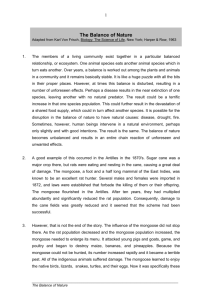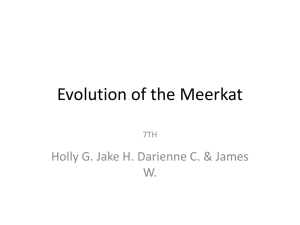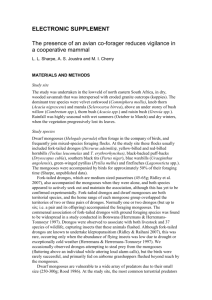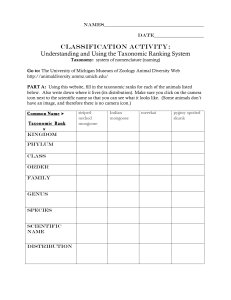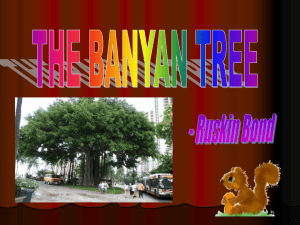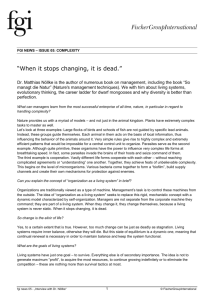Mongoose On The Loose
advertisement
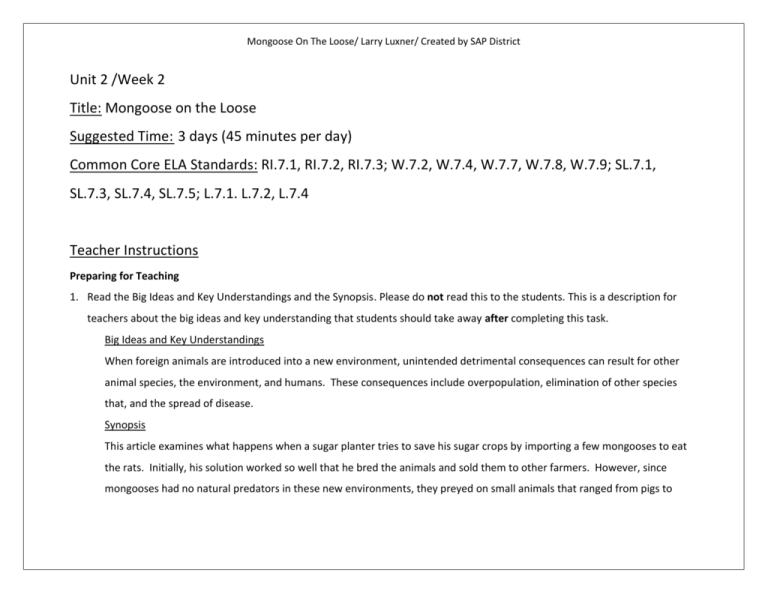
Mongoose On The Loose/ Larry Luxner/ Created by SAP District Unit 2 /Week 2 Title: Mongoose on the Loose Suggested Time: 3 days (45 minutes per day) Common Core ELA Standards: RI.7.1, RI.7.2, RI.7.3; W.7.2, W.7.4, W.7.7, W.7.8, W.7.9; SL.7.1, SL.7.3, SL.7.4, SL.7.5; L.7.1. L.7.2, L.7.4 Teacher Instructions Preparing for Teaching 1. Read the Big Ideas and Key Understandings and the Synopsis. Please do not read this to the students. This is a description for teachers about the big ideas and key understanding that students should take away after completing this task. Big Ideas and Key Understandings When foreign animals are introduced into a new environment, unintended detrimental consequences can result for other animal species, the environment, and humans. These consequences include overpopulation, elimination of other species that, and the spread of disease. Synopsis This article examines what happens when a sugar planter tries to save his sugar crops by importing a few mongooses to eat the rats. Initially, his solution worked so well that he bred the animals and sold them to other farmers. However, since mongooses had no natural predators in these new environments, they preyed on small animals that ranged from pigs to Mongoose On The Loose/ Larry Luxner/ Created by SAP District kittens. They also preyed on endangered species and spread minor rabies epidemics. This article also cites the research of scientists that are trying to help federal health officials to solve this problem. 2. Read the entire selection, keeping in mind the Big Ideas and Key Understandings. 3. Re-read the text while noting the stopping points for the Text Dependent Questions and teaching Tier II/academic vocabulary. During Teaching 1. Students read the entire selection independently. 2. Teacher reads the text aloud while students follow along or students take turns reading aloud to each other. Depending on the text length and student need, the teacher may choose to read the full text or a passage aloud. For a particularly complex text, the teacher may choose to reverse the order of steps 1 and 2. 3. Students and teacher re-read the text while stopping to respond to and discuss the questions, continually returning to the text. A variety of methods can be used to structure the reading and discussion (i.e., whole class discussion, think-pair-share, independent written response, group work, etc.) Text Dependent Questions Text-dependent Questions In the first paragraph on page 283, a sugar planter is faced with a problem and tries to solve it. Describe the problem and the solution. Did his solution prove to be successful? How do we know? On page 283, Luxner reports that without natural predators, the mongoose population exploded. Based on the information provided in this paragraph, how would the presence of natural predators prevent this mongoose population explosion? Evidence-based Answers Rats are eating up the planter’s sugar crops. He imports mongooses to eat the rats. The solution was so successful that he bred mongooses and sold them to other farmers that were eager to buy them. Wolves, coyotes, or poisonous snakes would have killed enough mongooses to keep them from reproducing at such a rapid rate. Mongoose On The Loose/ Larry Luxner/ Created by SAP District In the third paragraph on page 283, what information is provided that really shows the magnitude of the problem with the overpopulation of mongooses? What can you infer from this section that supports Horst’s conclusion that there is the potential for a real problem on these islands? On page 284, Horst mentions unintended consequences when they tried to rid the islands of mongooses. What are some of the examples cited in the article? What new technology does Horst use to study the life cycle and reproductive habits of the Caribbean mongoose? How does this new technology help his research? Horst suggests that federal health officials may decide to launch a campaign against rabies in Puerto Rico or the U.S. Virgin Islands. Why would studying mongooses help with this campaign? According to the information in this article, would you say that Horst is committed to solving the mongoose problem? Why or why not? In Puerto Rico, there is about one mongoose for every four humans. (800,000-1,000,000) In St. Croix, 100,000 mongooses which is twice the amount of the human population. You can’t poison the mongooses because cats, dogs, and chickens would get poisoned too. People’s pets could get poisoned. Also, people eat chicken which means that humans could get poisoned too. This means that the problem of the mongoose population could only get worse. When trying to kill off the mongooses, other species were killed including the Amevia lizard on St. Croix, presumed extinct for decades. The population of the Hawaiian goose has been reduced to a very low number. He uses microchips to track the mongooses’ habits. Ear tags would not be able to provide data to track mongoose behaviors. The microchips helped the scientists to discover that mongooses have a life expectancy of six to ten years which is much longer than they thought. Mongooses have spread minor rabies epidemics. (283) He is committed to solving the problem. His five-year study is being sponsored by Earthwatch and has funded at least 1300 research projects in 87 countries. Volunteers pay to help set traps that require them to walk at least 10 miles a day. Mongoose On The Loose/ Larry Luxner/ Created by SAP District Meaning needs to be provided Meaning can be learned from context Tier II/Academic Vocabulary These words require less time to learn These words require more time to learn (They are concrete or describe an object/event/ process/characteristic that is familiar to students) (They are abstract, have multiple meanings, are a part of a word family, or are likely to appear again in future texts) Page 283 - imported Page 283 - predators Page 283 - rabies Page 284 - decades Page 284 - implanted Page 284 - dramatically Page 284 - launch Page 284 - non-profit Page 284 - expectancy Page 283 - exotic Page 283 - endangered (species) Page 283 – epidemics Page 283 – potential Page 284 - presumed Page 284 - extinct Page 284 - devoured Page 284 - microchips Page 284 - transponders Page 283 - prophet Page 284 - campaign Mongoose On The Loose/ Larry Luxner/ Created by SAP District Culminating Writing Task Prompt At the beginning of Larry Luxner’s article, “Mongoose on the Loose,” he tells us about the Jamaican sugar planter that imported mongooses to kill the rats that devoured his crops. This decision solved his problem, but also resulted in an unintended consequence that scientists are still trying to solve today. The scientists are looking for ways to solve this problem without causing any additional unintended consequences. Think about what happened after the sugar planter sold more mongooses to other farmers. What were the unintended consequences that impacted wild life and the environment? What unintended consequences are the scientists trying avoid in their efforts to solve the mongoose problem? Is there any indication that this problem will be solved in the future? Compose an explanation is one page in length. Support your claims with valid reasoning and relevant and sufficient evidence from the text, including direct quotes and page numbers. Teacher Instructions 1. Students identify their writing task from the prompt provided. 2. Students complete an evidence chart as a pre-writing activity. Teachers should remind students to use any relevant notes they compiled while reading and answering the text-dependent questions. Evidence Quote or paraphrase “With no natural predators—like wolves, coyotes, or poisonous snakes—the mongoose population exploded, and within a few years, they were Page number 283 Elaboration / explanation of how this evidence supports ideas or argument At the beginning of the article, Luxner is direct and explicit regarding unintended negative consequences of importing the mongooses. Mongoose On The Loose/ Larry Luxner/ Created by SAP District killing not just rats but pigs, lambs, chickens, puppies, and kittens.” The mongooses also “threatened endangered species and spread minor rabies epidemics.” Because they had no natural predators, the mongooses reproduced rapidly which resulted in their overpopulation. In Puerto Rico, there are from 800,000 to one million mongooses which is about one mongoose for every four humans. “In St. Croix, there are 100,000 mongooses about twice as many as the human population.” Initial efforts to kill off the mongooses resulted in the unintended consequences of killing off or reducing numbers of a number of other species. (Amevia lizard, Hawaiian goose) In an effort to solve this problem, Horst is using microchips to study the life cycle and reproductive habits of the Caribbean mongoose. 283 This was definitely an unintended consequence. 283 This threatened pets as well as small wild animals, including endangered species. 283 This illustrates the seriousness of this problem. 284 Poison didn’t work either because they could not ensure that only the mongooses would have access to it. 284 By gathering as much data as possible, Horst hopes to help provide federal health officials with the information needed to find a solution that will not endanger other species, humans, or the environment. 3. Once students have completed the evidence chart, they should look back at the writing prompt in order to remind themselves what kind of response they are writing (i.e. expository, analytical, argumentative) and think about the evidence they found. (Depending on the grade level, teachers may want to review students’ evidence charts in some way to ensure accuracy.) From here, students should develop a specific thesis statement. This could be done independently, with a partner, small group, or the entire class. Consider directing students to the following sites to learn more about Mongoose On The Loose/ Larry Luxner/ Created by SAP District thesis statements: http://owl.english.purdue.edu/owl/resource/545/01/ OR http://www.indiana.edu/~wts/pamphlets/ thesis_statement.shtml. 4. Students compose a rough draft. With regard to grade level and student ability, teachers should decide how much scaffolding they will provide during this process (i.e. modeling, showing example pieces, sharing work as students go). 5. Students complete final draft. Sample Answer In his article essay, “Mongoose on the Loose, Larry Luxner chronicles what happened when mongooses were imported to a foreign land with no natural predators. The fact that mongooses had no natural predators resulted in the unintended consequence of overpopulation that led to the “killing of not only rats but pigs, lambs, chickens, puppies, and kittens” (283). The animals that were under attack included not only food sources for humans, but pets as well. The mongooses also “threatened endangered species and spread minor rabies epidemics” (283). The article begins with a sugar farmer who decides to import mongooses to kill the rats that were devouring his sugar crops. This solution worked so well that other farmers wanted to buy mongooses to protect their crops as well. However, they did not know that this solution would cause even greater problems in the very near future. Because they had no natural predators, the mongooses reproduced rapidly which resulted in their overpopulation. There were so many of them that they threatened the population of small animals and endangered species. As time progressed, mongooses continued to reproduce to the point where they were catching up with the human population. In Puerto Rico, there are from 800,000 to one million mongooses which is about one mongoose for every four humans. “In St. Croix, there are 100,000 mongooses, about twice as many as the human population” (283). These numbers Mongoose On The Loose/ Larry Luxner/ Created by SAP District clearly indicate a real problem. Dr. Horst, a biology professor, said that this situation had “the potential for real trouble” (283). Due to the magnitude of the mongoose issue, there were attempts to kill them off. However, these initial efforts resulted in the unintended consequences of killing off a number of species, including the Amevia lizard on St. Croix, that were originally believed to be extinct. The population of the Hawaiian goose has also been seriously reduced. They also thought about poison, but cats, dogs and chickens could get poisoned as well. In an effort to solve this problem, Horst is using microchips to study the life cycle and reproductive habits of the Caribbean mongoose (284). He has already learned that mongooses have a life expectancy of six to ten years, as opposed to three to five years as they previously thought. Horst is committed to gathering as much data as possible to help provide federal health officials with the information needed to find a solution that will not endanger other species, humans, or the environment. With the support of Earthwatch Incorporated and volunteers, Horst’s study will hopefully produce good results and the Caribbean Islands will be mongoose free! Additional Tasks Conduct a short research project on other types of invasive species and their unintended consequences. Choose at least two animals and draw evidence from three sources (digital or print). Take notes on your findings in the form of quotes and paraphrases. After you have gathered your findings, create a 4-minute presentation for your classmates. Include at least one visual display in your presentation in order to enhance and clarify information. After your presentation, submit your research notes, along with a bibliography to your teacher. Answer: Answers will vary. Some species that students might research include: purple loosestrife, zebra mussels, Asian longhorned beetle, or cane toads. Mongoose On The Loose/ Larry Luxner/ Created by SAP District Should there be laws regarding invasive species? Divide the class into two groups and have a debate on this question. Provide students time to prepare their arguments with their teams. When debating, students should pay particular attention to the other team’s arguments in an effort to analyze and evaluate their claims and reasoning. This task could lead to a broader discussion of government regulation. Answer: Answers will vary. Teachers should keep in mind that the Standards require arguments to be based on logical reasoning and relevant evidence, not just opinions. This task would be a good one to illustrate what that means. Mongoose On The Loose/ Larry Luxner/ Created by SAP District

